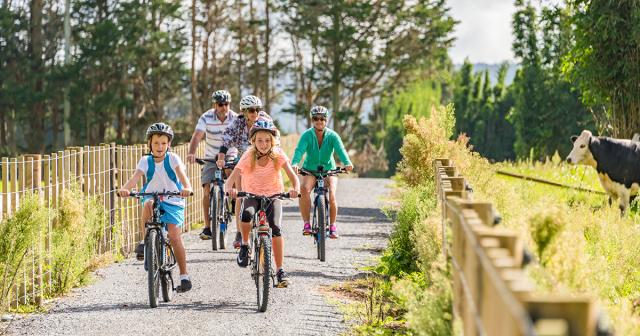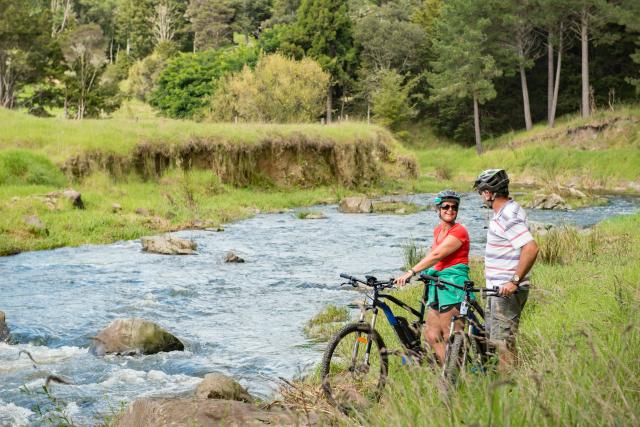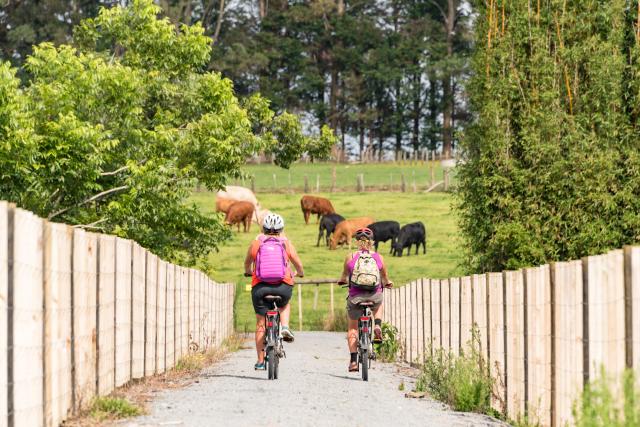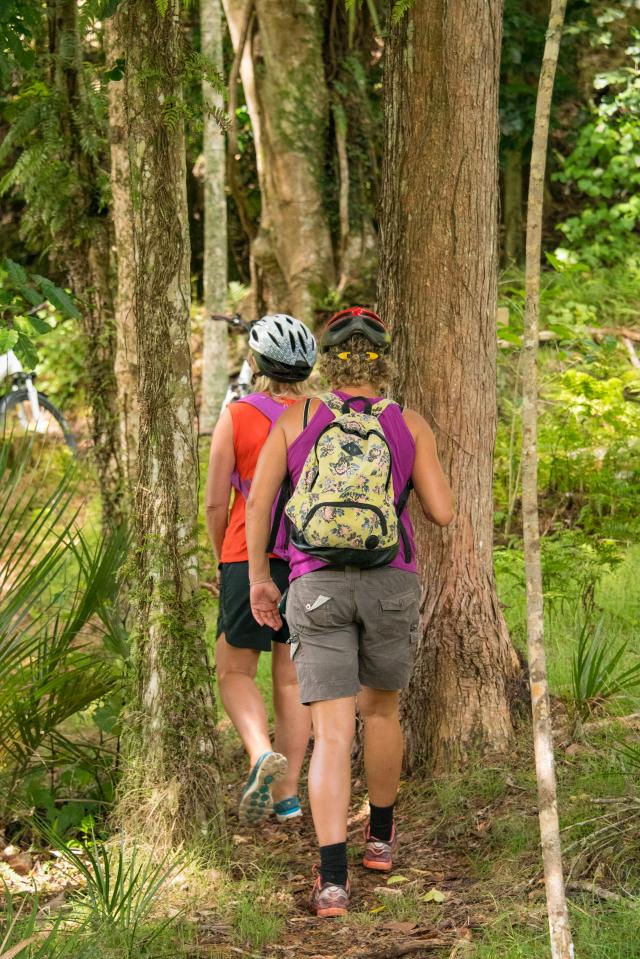After 50 years of sharing knowledge, friendship and a boundary fence, two Northland farming families are now collaborating to support a cross-Northland trail.

All ages can enjoy Northland’s Twin Coast cycle and walking path. Photo: Pou Herenga Tai
Snow and Robyn Harrison and Neville and Linda Lewis have farmed sheep and beef on neighbouring farms near Kaikohe for 53 years.
Their properties are on the 87km Pou Herenga Tai – Twin Coast Cycle Trail, which is also popular with walkers.
Linking the Bay of Islands on the east coast with Hokianga Harbour on the west, it’s the only one of the 23 Great Rides of New Zealand to traverse the country coast-to-coast.
Trail highlights include spectacular forests and lakes, some of the country’s most historic Māori and European settlements, a vintage rail trip – and a 6km section through the Lewises’ and Harrisons’ hill country farms.
They are two of five farmers in the Ōkaihau-Utakura area to give land for the trail through a legal easement, trail manager Tracy Dalton said.
These are perpetual leases, meaning they remain public access even if the farms change hands.
She said such generosity was characteristic of those farmers.
“They care about their community and anything to make the trail work was a positive for them.”

Riders enjoy the riverside trail through Snow and Robyn Harrison’s farm near Kaikohe, Northland. Photo: Pou Herenga Tai
It’s a win-win
Neville and his wife Linda farm around 1000 Romney ewes and 200 Angus cows on their 540 hectares of mostly steep country.
A 2.5km strip of that is now cycle trail.
Neville said both he and Snow have benefited from supporting the project, but that wasn’t their motivation.
“We live in quite a pretty valley. It was an amazing place back in the day – a lot of history. We have a small village, Ōkaihau, and another called Hōreke on the Hokianga. They were struggling to survive, with post office closures and so on. Snow and I thought allowing cyclists to go through would benefit them.”
Now those communities were slowly transforming, he said.
“Everything needs a helping hand.”

Cyclists on the section of the Pou Herenga Tai trail that goes through Neville and Linda Lewis’s farm get a unique glimpse into a working farm. Photo: Pou Herenga Tai
This generosity notwithstanding, the two men, who are also trustees for the trail, have found supporting it a win-win situation.
“The strip of land I gave up for the trail was probably some of the best I had, through quite nice river flats. But I wasn’t overly worried – there have been several benefits,” Neville said.
Grants from the trail trust paid for the fencing-off of the riverside section through the farms and an area of native bush, as well as some retaining and stabilisation work.
“It took us about four or five years to get it usable, because we’ve got farms to run. But we probably wouldn’t have done all that on our own, because of the cost,” Neville said.
“It was a win for us and a win for the trail.”
The funding came through the local council, which allowed Neville and Snow to manage the upgrades themselves.
“The council foreman trusted us, he said: you know your land and what you’re doing. We hired contractors we knew and had worked with, the digger driver, the fencer.”
Another benefit was help with weed removal and native planting to enhance the trail’s biodiversity corridor.
The Lewises are also looking into ways of leveraging business opportunities for family members off the trail.
Perhaps the most rewarding thing, though, was seeing how much joy the trail generated, Neville said.
“It’s bloody amazing to see the amount of people enjoying a ride. Older people too, and young kids – with these modern electric bikes, it transforms things.”
He encouraged other farmers to consider allowing access through their farms to “give it a crack”.
“If that would open opportunities for you, I’d say go for it. But make it work for you – if there’s infrastructure required and there’s funding, get it – it’s got to be a two-way thing.”
Injecting back
Snow and his wife Robyn fatten beef cattle and graze dairy cows on their mostly hilly, 218ha farm.
They now also host a 3.5km section of the cycleway.
Snow said they did it to put something back into the area, which has done it tough over recent years.
“We can’t have it all to ourselves – we’ve got to show it around and inject something back.”
He now has a museum, which cyclists often visit. It includes vintage cars, tractors, and a blacksmith shop.
He said while some people might worry about privacy with a trail through their land, his experience had been totally positive.
“You can get a bit lonely on the farm, and if you see a lot of people coming through, it’s good. They’re all good people; I haven’t struck a bad one yet. You never find rubbish on the track, nothing like that.”
Like Neville, his advice to other farmers considering something similar was to go for it.
“There could be a business in it for you. You could put in accommodation, diversify. It helps keep the farm going. That’s what needs to happen, especially on hill country farms.”
This article was written as part of a joint project between Beef + Lamb New Zealand and Herenga ā Nuku Aotearoa, the Outdoor Access Commission, to highlight the ways sheep and beef farmers around the country are supporting public access to the outdoors.
Read more
Tararua sheep and beef farmers Marty and Debbie Hull have given access to the public to their “magical” waterfall for the entire 20 years they have owned the farm.
The Stuart family of historic Cable Bay Farm near Nelson has long welcomed New Zealanders and overseas visitors onto its scenic land via a public walking track.
More information
- Interested in having public access through your land? More information: Benefits of creating legal access on your land
- Would you or someone you know like to share a story like this? Get in touch: [email protected]

Trampers on the section of the Twin Coast Cycle Trail that traverses Snow and Robyn Harrison’s farm. Trail manager Tracy Dalton said walker numbers had been increasing recently. Photo: Pou Herenga Tai